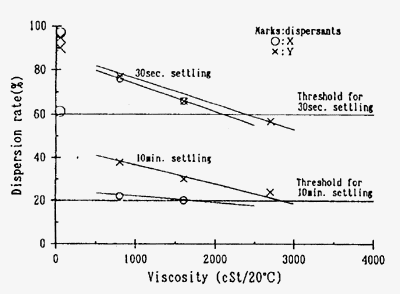The results of the tests are given in Table 3 and Fig. 2.
Dispersion rate of dispersant X(marked O) after a settling time of 10 minutes on 1,600
cSt viscosity oil just met 20%, therefore, the tests on 2,700 cSt viscosity oil were not
conducted.
Dispersion rate of dispersant Y(marked x ) after a settling time of 30 seconds on 2,700
cSt viscosity oil was 57% which failed to exceed Japanese threshold of 6096. The test
results show that the higher the viscosity the lower the dispersion rates are.
From the above-mentioned results it has been found that currently available dispersants
have significantly low dispersion rates against oil with viscosity of more than 3,000 cSt.
This suggests that the resurfacing quantity of oil droplets grows more as time goes on
because the resurfacing rate of droplets increases with the droplet sizes. Dispersant X
comes obviously under the fact mentioned above.
Dispersion rate of dispersant X and Y on heavy fuel oil (bunkerB) are given in Table 3
and Fig. 2.
Table 3 Relation between oil viscosity and dispersion rates
| Viscosity(cSt) |
|
800 |
1600 |
2700 |
| dispersion rate |
X |
30sec |
76 |
66 |
- |
| 10min |
22 |
20 |
- |
| Y |
30sec |
77 |
66 |
57 |
| 10min |
38 |
30 |
24 |

Fig 2 Relation between oil viscosity and dispersion rate
3 Development of dispersants for high-viscosity oils
In emulsification of curently available conventional dispersants against high-viscosity
oils, the droplet size is much larger, as mentioned above. This is based on the reason
that dispersed oil with high viscosity in the water column have a marked tendency to
coalesce following coherence of droplets resurfacing in the water, that is called the
Creaming phenomenon.
Some of the important factors that the dispersants are unable to make the oil droplets
smaller are as follows:
・ The permeability of the solvent in the conventional dispersant is too weak to
reduce the viscosity of high-viscosity oils.
・ The surfactant, the other component of the conventional dipersant, have low ability
to reduce surface tention of high-viscosity oil.
Paying their attention to the points stated above, the authors have commenced the study
on the development of dispersants for high-viscosity oils.
3.1 Surfactants and solvents used
Twenty surfactants and 10 solvents were used in various combinations for testing their
effectiveness. The screening tests were carried out at constant surfactant-solvent ratio
of 2 : 8.
3.2 oil used
Oil shown in Table 4 was used. Viscosity at 9.5℃,15℃, 20℃ and 24℃ were measured
with a rotation viscosimeter. The relation between viscosity and temperature is given in
Fig. 3. These tests were conducted at 25 on oil with a viscosity of 10,000 cSt.
Table 4 Properties of the heavy fuel oil
| Specific Gravity(15℃)g/cm3 |
0.993 |
| Flash Point |
110 |
| Viscosity(cSt) |
at 50% |
850 |
| at 24% |
12,240 |
| at 20% |
24,000 |
| at 5% |
60,000 |
| at 9.5% |
144,800 |
| Pour Point
℃ |
12.5 |
| Carbon Residue wt% |
15.8 |
| Total Sulfur
wt% |
2.56 |
| Total Ash
wt% |
0.03 |
前ページ 目次へ 次ページ